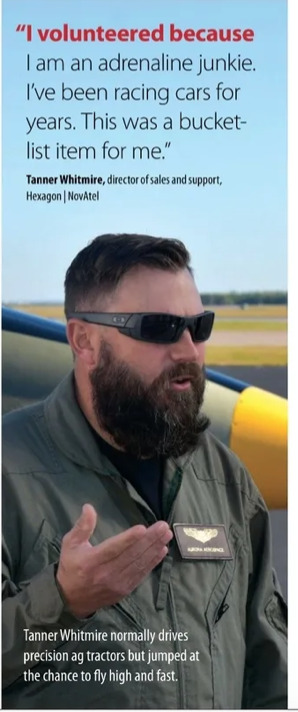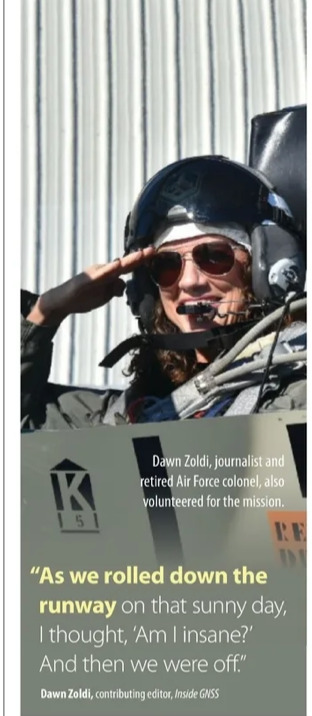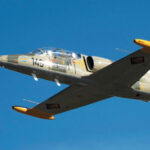Skin in the Game – Engineers Subject Themselves to Sensor Fusion
Two Hexagon I NovAtel employees and a reporter sacrificed their bodies in the name of science by riding in the jump seat of an Aero Albatros fighter training jet during the L-39 demonstrations. Here, we get the perspectives of those brave souls and the mastermind behind the unique human aspect of this experiment.
Extreme test and evaluation (T&E) runs in the DNA at Hexagon | NovAtel. And I mean extreme.
In 2019, the team tested its IMUs in a skydiving scenario. That experience led the team to start thinking about how to introduce more complexity to their T&E through even more advanced maneuvers. Miguel Amor, chief marketing officer, said that’s when the idea was born to expose the IMUs to the power, speed and machinations of a twisting, turning, swooping, diving, gyrating fighter jet.
“We consider we have the best tech for GNSS/inertial navigation system (INS) integration,” Amor explained. “We always try to find the most aggressive applications to push the limits of the tech. The jet is the most aggressive platform for some of the attitudes we wanted to test.”
In 2021, Hexagon | NovAtel engineers made the idea a reality. After only about six months of planning, the flights took place in Tampa in early December.
Extreme Attitude
Among others, the engineering team’s wish list of maneuvers, including combat maneuvers, to max out the capabilities of its IMUs included:
• Coordinated turns: forces acting on the airplane in a turn are perfectly balanced. In other words, the plane turns but its occupants are not pushed or pulled in any direction in their seats.
• Aileron rolls: aerobatic maneuvers in which an aircraft does a full 360° revolution about its longitudinal axis
• Medium and high G turns: maneuvers that allow the pilot to make sharper turns than normal
• Immelmann turns: also known as a roll-off-the-top, an aerobatic maneuver that results in level flight in the opposite direction at a higher altitude
• Stalls: an aircraft’s angle of attack increases beyond a certain point, at which the lift begins to decrease
• Steep dives: sharp descending flight paths
• Split S: the pilot half-rolls the aircraft inverted and executes a descending half-loop, producing level flight in the opposite direction at a lower altitude
• Dynamic weave: a dramatic and demanding maneuver in which an airplane flying at a moderate speed suddenly raises the nose momentarily to the vertical position and slightly beyond vertical with an extremely high angle of attack, momentarily stalling the plane and making it a full-body air brake, before dropping it back to normal, during which the aircraft does not change effective altitude
The IMUs zipped through the national airspace over the Gulf of Mexico, wedged between the front and back seats of the jet, subjected to these maneuvers at top speeds between 333 and 510 mph. As they did, the team recorded more than just inertial measurements. They also captured the whole radio frequency (RF) spectrum.
“Understanding the scope of the problem of the RF interference environment will help shape our solutions,” Amor noted. The team plans to use these terabytes of high-value data in future simulations, consistent with the overall objectives of the experiment.
The first experimental objective was to show the tech could perform in a combat environment. The second objective was to illustrate the tech could be customized for commercial use, such as autonomous cars that might experience vibrations similar to the jet’s turbulence. Both of these objectives tied directly back to the company’s future PNT/GNSS road map.
The third objective was more personal. Hexagon | NovAtel decided to put some of its employees in the jet to ride along with the IMUs as an incentive flight. Amor, who hatched this part of the plan, elaborated: “We wanted our team to have a once-in-a-lifetime experience, while doing something good for the technologies that they could share with industry.”
With these objectives in mind, the team adopted the tagline “Extreme Attitude” for the experiment. It had two meanings. From the technical standpoint, it captured the behavior of the jet’s pitch, roll and other dynamic maneuvers to which the IMUs would be exposed.
“Extreme Attitude” also captured the spirit of the team, always seeking next-level ways to push boundaries.

Bodies on the Line for Science
As the engineers developed the parameters of the experiment, Amor and his marketing team pushed out a lottery to all Hexagon | NovAtel employees for the jet ride-along.
“We wanted to show our employees that we are working on serious problems with real-world applications,” he noted. “The employee lottery added motivation for everybody about the importance of our mission. It helped activate a high attitude culture within the team.”
Tanner Whitmire, the company’s director of sales and support who proactively leads and assists the global sales team to grow Hexagon | NovAtel’s autonomous agriculture market vertical, was randomly selected in the lottery. Whitmire said he accepted because he is an “adrenaline junkie.” He has been racing cars for years and has broken close to 20 bones over his career. “This was a bucket-list item for me,” he said.
After Whitmire’s flight, Amor conducted a second lottery of the three engineers on site. The lucky winner was Sam Kiley-Kubik, an inertial navigation expert who has worked with the Sensor Fusion group at NovAtel for more than 12 years on system verification and system design across a broad spectrum of markets including aerospace, agriculture, defense and survey. During L-39, he provided support as a geomatic software expert to make sure the programs functioned and operated correctly. He worked with the Calgary team for months as they designed the mount for the IMUs and conducted data post-testing analysis.
“It seemed like it would be an incredible experience, a fantastic opportunity,” Kiley-Kubik recalled. “I’ve always been a fan of jets. I also felt confident going into the flight that I would not get sick, which, in the end, did not hold up.”
IMUs Survived; Co-Riders, Not So Much
Bryan Leedham, the product manager of enclosures and post-processing software at Hexagon | NovAtel, who oversees the renowned SPAN GNSS+INS sensor fusion technology, said “This was a unique integration, the first time we integrated into a fighter jet for our own testing purposes. It was exciting. We were pushing the boundaries. Stuff like this campaign is evidence that we are right there with our clients. Wherever partners are trying to position, we are literally right there with them. And whatever we could throw at the sensors, they held up.”
On the other hand, both Whitmire and Kiley-Kubik became members of the “blue bag” (airsickness bag) club. The sensors and machines outperformed the humans.
Whitmire experienced max speeds of 333 mph, barrel rolls and 4Gs. “For me, when the plane went from extreme to leveling out, my body just did not know how to respond,” he recalled. He came off the jet holding his blue bag and looking incredibly shaken.
Even in the face of Whitmire’s post-flight condition, Kiley-Kubik still raised his hand to go next. He too, succumbed. He remembered queasiness building up early in flight, with the high G turns and then rolls. “We would do a roll and then wait for a roll. After the rolls and stall maneuver, I asked the pilot to level it out. At some point, I got sick,” he said.
Kiley-Kubik is still not sure whether he lost consciousness sometime between the Split S and Immelmann maneuvers. “I wasn’t prepared for the G load. My vision blacked out.” He remembers seeing 4.5Gs on the instrumentation before things got fuzzy. It’s no wonder. Records show he experienced top speeds of 425 mph.
Yet, despite this, both Hexagon | NovAtel employees, without hesitation, said they would do it all again. Kiley-Kubik had only one caveat. “I first would practice my lower body squeeze to hold consciousness better.”
Not only was this experience a once-in-a-lifetime opportunity for these brave souls, the entire team learned valuable lessons that will inform future work.

Lasting Impacts
Looking back, Kiley-Kubik knew the IMUs and GNSS receivers would hold up better than he was going to. “This is what inertial tech was built to do. The test data we are going to get from this about quality levels of different IMUs and antennas, which would not be possible without doing flights like these, is going to be incredible,” he said.
Similarly, Whitmire, who before NovAtel spent more than 10 years in the corporate precision agriculture field managing operations at an active farm, already understood the challenges facing farmers and the importance of providing positioning and assured autonomy. Being able to feel the pressure and disorientation of having his “own gyros not in sync” helped him to feel and see, firsthand, what the equipment goes through. This convinced him NovAtel’s products are going to perform in the most difficult environments.
In agriculture, Whitmire explained, while speed may not be relevant (a jet at 400 mph vs. a tractor at 4 mph), the ruggedness of the solution and knowing a product can withstand the extreme conditions of a high-dynamic environment matters. The ability to continuously perform under the most harsh conditions is key, whether in a fighter jet or in a crop field.
“Just like the jet could experience a signal outage when flying upside down with the sky out of view, a tractor could drive next to a tree line and similarly not have the visibility needed to perform,” he surmised. “Being able to handle GNSS in a jet speaks to the quality and reliability and ruggedness of our solution in agriculture and other commercial markets.”
Leedham, who has integrated GNSS and INS positioning technologies into myriad applications around the globe and has years of hands-on experience in the automotive and autonomy space, elaborated: “People might think agricultural applications, being lower and slower than a jet, may not translate. But it’s all about range and ruggedness. Some agricultural environments can mimic the jet’s motion readings due to things like the shocks from vibrations that occur over rough terrain.”
Whitmire agreed. “The jet scenario intensified what we might see in an ag application by a factor of five times or more. If we are able to ensure the solution works in an intensified situation, we know it will work in one that is less so.”
On the human side, Amor believes having employees onboard with the IMUs produced greater levels of engagement with this project than he has seen in the past. He plans to have Whitmire and Kiley-Kubik give presentations to their colleagues about their experiences to help keep the internal momentum going. Given the success of L-39, he plans to institute similar employee engagement programs in the future.
In the end, the main value of the experiment was that it showed the equipment is robust and will work, whether slow like ag or wild like jet. The team squeezed out every ounce of performance for inertial GNSS fusion. They plan to use the technical data to verify, validate and refine algorithms for fixed wing and unmanned aircraft flights, when maximum reliability is needed.

Reporting From the Jump Seat
Having dedicated nearly 27 years in service to the U.S. Air Force as both an active duty military and federal civilian attorney, I had opportunities to experience some interesting things from an aviation standpoint. Early in my career, I got to fly up and down a chunk of the California coastline in a helicopter. I took an FBI small charter to Cuba during my deployment to Guantanamo Bay in 2004. As a more senior officer, I spiraled into Kabul, Afghanistan, lights off, during a combat landing in a cargo plane.
Never before had I sped through the air in the jump seat of a fighter jet…until now.
As Amor hatched his plan to put some of the company’s employees in the fighter jet with its IMUs, he reached out to Inside GNSS to see if the magazine wanted to embed a journalist into the experiment.
The goal was to lend additional credibility to the human element of the experiment by allowing a reporter to go literally along for the ride, see the company’s work first-hand and provide a different point of view.
I was asked to participate because of my Air Force background. I agreed, much like Whitmire and Kiley-Kubik, because I knew this would be the chance of a lifetime.
It was. In every way.
I arrived onsite just after Whitmire had finished his flight. I saw how tough it was on his body and how the equipment remained intact. I sat through the flight briefing with Kiley-Kubik and watched him take off, land and exit the jet, also looking a bit worse for the wear. I flew the next day.
After having a bit of a restless night, there was definitely a part of me that was concerned about whether I would make it through the flight without passing out or getting sick. Some of the engineers were taking bets on the side.
That morning, I made sure not to eat or drink anything. I got up early, put a Dramamine patch on and made my way to the flightline. After an in-cockpit brief about how to punch out in the event of an emergency, I sat back and listened as the pilot spoke with the tower. We were ready to go wheels up.
As we rolled down the runway on that bright and sunny day, I recall thinking, “Am I insane?” And then we were off.
The initial flight was smooth. Our plan was to rendezvous with some of the Hexagon folks, who had taken a boat out into the Gulf of Mexico with the camera crew, to give them some close up “fly by” footage.
Initially, we could not find the boat. When we did, just a few minutes in, the real fun started. I remember buzzing the boat at speeds up to 337 mph, sideways. I made it through several rounds of barrel rolls, vertical ascents and a lot of circling that boat. I could feel the Gs pressing on my body and head.
It started to get to me once we switched directions, two barrel rolls in. I was breathing deeply (think Lamaze). I reached for the blue bag. My stomach squinched, but alas, Lady Luck prevailed. I never did get sick.
In the end, the equipment in that jet never flinched, but the humans did in one way or another. Overall, like my Hexagon colleagues, I would do it all again. It was absolutely spectacular.
And I did, in fact, have the time of my life.

Continue reading (Part Three)…






